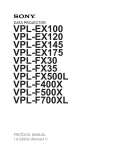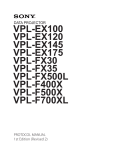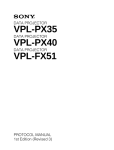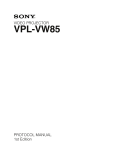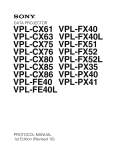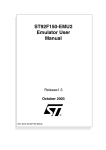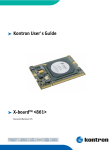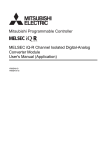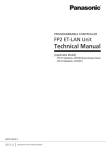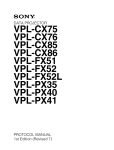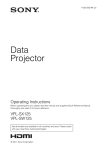Download Sony Projector VPL-EW130 User's Manual
Transcript
DATA PROJECTOR VPL-EW130 VPL-SX125 VPL-SW125 PROTOCOL MANUAL 1st Edition (Revised 1) ! ! WARNING This manual is intended for qualified service personnel only. To reduce the risk of electric shock, fire or injury, do not perform any servicing other than that contained in the operating instructions unless you are qualified to do so. Refer all servicing to qualified service personnel. ! WARNUNG Die Anleitung ist nur für qualifiziertes Fachpersonal bestimmt. Alle Wartungsarbeiten dürfen nur von qualifiziertem Fachpersonal ausgeführt werden. Um die Gefahr eines elektrischen Schlages, Feuergefahr und Verletzungen zu vermeiden, sind bei Wartungsarbeiten strikt die Angaben in der Anleitung zu befolgen. Andere als die angegeben Wartungsarbeiten dürfen nur von Personen ausgeführt werden, die eine spezielle Befähigung dazu besitzen. ! AVERTISSEMENT Ce manual est destiné uniquement aux personnes compétentes en charge de l’entretien. Afin de réduire les risques de décharge électrique, d’incendie ou de blessure n’effectuer que les réparations indiquées dans le mode d’emploi à moins d’être qualifié pour en effectuer d’autres. Pour toute réparation faire appel à une personne compétente uniquement. VPL-EW130 Table of Contents 1. Overview 1-1. Introduction ........................................................................ 1 1-2. Glossary of Terms .............................................................. 1 1-3. Protocol Stack Structure ..................................................... 1 2. Common Commands 2-1. Sub Commands .................................................................. 3 2-1-1. ITEM List ................................................................. 3 2-1-2. Infrared Remote Command Code ............................. 6 2-2. Reply .................................................................................. 7 3. RS-232C 3-1. Connection ......................................................................... 7 3-2. Communication Specifications........................................... 7 3-3. Communication Procedure ................................................. 8 3-3-1. Outline of Communication ....................................... 8 3-4. Communication Rules ........................................................ 8 3-5. Approximate Return Waiting Times................................... 8 3-6. Command Block Format .................................................... 9 3-6-1. Simplified Command ................................................ 9 3-7. Packet Examples .............................................................. 10 3-7-1. Change “ASPECT” to “ZOOM” ............................ 10 3-8. AMX Device Discovery ................................................... 10 4. Ethernet 4-1. Service ...............................................................................11 4-1-1. Advertisement ..........................................................11 4-1-2. PJ Talk..................................................................... 12 4-2. Communication Procedure ............................................... 13 4-3. Protocols ........................................................................... 14 4-3-1. SDAP ...................................................................... 14 4-3-2. SDCP....................................................................... 15 4-3-3. PJLink ..................................................................... 24 VPL-EW130 1 (T) 1. Overview 1-1. Introduction The projector is remotely controllable over RS-232C as well as Ethernet. It is useful for setting up the projector away from the operator. This protocol manual describes the specifications such as packet format and procedures for controlling the projector. In the following sections below, the term “CONTROLLER” is used as a device which controls the projector. CONTROLLER can be a PC or other specific device that is able to handle RS-232C or Ethernet. Although most of commands are available for both RS-232C and Ethernet, some commands are dedicated to Ethernet. * Ethernet is a registered trademark of Xerox Corporation. 1-2. Glossary of Terms Table 1-1 Glossary of Terms Terms Abbreviated Description CONTROLLER _ Command initiator such as PCs. PROJECTOR _ Front projector. SDAP Simple Display Advertisement Protocol Protocol name for advertising the projector status over Ethernet. SDCP Simple Display Control Protocol Protocol name for controlling projector over Ethernet. PJLink _ Protocol name for controlling projector over Ethernet. 1-3. Protocol Stack Structure The protocol stack structure diagram is shown below. Though the stack is drawn for RS-232C and Ethernet separately, the following portions are common. Table 1-2 Common Portions in Protocol Stack Layer Name Description Sub Command Value is assigned for projector’s functions. Refer to the section 2-1 for detail description. Simplified Command Packet format for sending/receiving “Sub Command”. Refer to the section 3-6-1 for detail description. VPL-EW130 1 (1) RS-232C Sub Command AMX Device Discovery Simplified Command Asynchronous RS-232C Fig. 1-1 RS-232C Protocol Stack “RS-232C” layer is physical portion and “Asynchronous” is the traditional protocol layer as shown in the section 3-2. (2) Ethernet SDCP Specific Command HTTP Sub Command PJLink SNMP SDAP DDDP Simplified Command SDCP (PJ Talk) UDP/IP TCP/IP Ethernet Fig. 1-2 Ethernet Protocol Stack Ethernet corresponding model VPL-SX125, VPL-SW125 Because of traditional portions for Ethernet general layer, “TCP/IP”, “UDP/IP” and “HTTP” are out of scope in this document. SDCP specific command is described in the section 4-3-2. SDAP and SDCP (PJ Talk) are SONY original protocol stack, which are described in the sections 4-3-1 and 4-3-3 respectively. 2 VPL-EW130 2. Common Commands 2-1. Sub Commands Sub Command is the value which is used by Simplified Command. Value is assigned for executing function. For example, if you want to change the picture mode, the appropriate value assigned for the desired picture mode should be chosen. 2-1-1. ITEM List Item lists are described below. Tables are shown per function category. ITEM List For Picture <Table 1> <Table 2> Item Number Data Remarks Item Upper byte Lower byte Data Byte PICTURE MODE 00h 02h DYNAMIC 0000h STANDARD 0001h PRESENTATION 0002h GAME 0003h LIVING 0004h CINEMA 0005h CONTRAST 00h 10h VALUE 0000h-0064h(0-100) BRIGHTNESS 00h 11h VALUE 0000h-0064h(0-100) COLOR 00h 12h VALUE 0000h-0064h(0-100) HUE 00h 13h VALUE 0000h-0064h(0-100) SHARPNESS 00h 14h VALUE 0000h-0064h(0-100) VOLUME 00h 16h VALUE 0000h-0064h(0-100) COLOR TEMP 00h 17h HIGH 0000h DDE VPL-EW130 00h 18h MID 0001h LOW 0002h OFF 0000h PROGRESSIVE 0001h FILM 0002h Set/Get 3 ITEM List For Screen <Table 1> <Table 2> Item Number Data Item Upper byte Lower byte ASPECT 00h 20h Remarks Data Byte FULL 0000h NORMAL 0001h ZOOM 0003h FULL1 0007h FULL2 0008h FULL3 000Ch WIDE ZOOM 0002h 4:3 0009h 16 : 9 000Ah Set/Get ITEM List For Setup <Table 1> <Table 2> Item Number Data Item Upper byte Lower byte INPUT TERMINAL 00h 01h Remarks Data Byte VIDEO 0000h S-VIDEO 0001h INPUTA 0002h INPUTB 0003h PICTURE MUTING 00h 30h OFF 0000h ON 0001h AUDIO MUTING 00h 31h OFF 0000h ON 0001h INPUT A SIGNAL-SEL 00h 32h AUTO 0000h COMPUTER 0001h COMPONENT 0002h VIDEOGBR 0003h LAMP MODE 00h 40h HIGH 0000h STANDARD 0001h LOW 0002h Set/Get ITEM List For Infrared Remote Command <Table 1> <Table 2> Item Number Remarks Data Item Upper byte Lower byte Data Upper byte Lower byte Infrared Remote Command (15 bit category) 17h Refer to Section 2-1-2.*1 _ 00h 00h Infrared Remote Command (20 bit E category) 19h _ 00h 00h Infrared Remote Command (20 bit EE category) 1Bh _ 00h 00h Set only *1: For using this item number, the simulation of the infrared remote controller is enable. Select the corresponding code in the table of Section 2-1-2 and use it as the lower byte of the item number. n Other value (the upper byte) is assigned depending for category. 4 VPL-EW130 ITEM List For Status <Table 1> <Table 2> Item Number Data Item Upper byte Lower byte STATUS ERROR1 01h 01h STATUS POWER 01h 02h Remarks Data Byte NO ERROR 00h LAMP ERROR 01h FAN ERROR 02h COVER ERROR 04h TEMP ERROR 08h STANDBY 00h STARTUP LAMP 02h POWER ON 03h COOLING1 04h COOLING2 05h SAVING COOLING1 06h SAVING COOLING2 07h SAVING STANDBY 08h LAMP TIMER 01h 13h VALUE xxh SUB ROM VERSION 01h 1Dh VALUE xxh MAIN ROM VERSION 01h 1Eh VALUE xxh STATUS SECURITY 01h 1Fh DISABLE 00h ENABLE 01h VPL-EW130 Get only 5 6 VPL-EW130 VOL:SMALL x3 x2 APA x0 PHASE x1 7x 6x 5x 4x 3x 2x 1x 0x x0 ECO MODE x1 20bit PROJECTOR-EE 7x 6x 5x 4x 3x 2x 1x 0x 20bit PROJECTOR-E 7x 6x x2 x3 x3 x4 x4 CURSOR ← PICTURE MUTING AUDIO MUTING x4 x5 x5 CURSOR ↑ STATUS ON POWER TOGGLE x5 x6 x6 CURSOR ↓ STATUS OFF x6 x7 x7 FREEZE x7 INPUT TOGGLE CURSOR → SHARPNESS SHARPNESS + _ VOL LARGE x2 PITCH HUE _ x1 5x HUE + x0 4x 3x 2x 1x 0x 15bit PROJECTOR 2-1-2. Infrared Remote Command Code x8 x8 SHIFT CONTRAST + x8 x9 x9 MENU CONTRAST _ x9 xA DIGITAL ZOOM + V KEYSTONE xA ENTER VIDEO COLOR + xA xB DIGITAL ZOOM _ xB RESET INPUT A COLOR _ xB xC xC INPUT B xC xD xD xD xF xE ASPECT TOGGLE xE POWER ON xF xF S VIDEO POWER OFF BRIGHTNESS BRIGHTNESS + _ xE 2-2. Reply <Table 3> Item Number Item Data Data Upper byte Lower byte ACK Complete 00h 00h NAK Select Error 01h 05h 3. RS-232C 3-1. Connection Communication is enabled by the use of a D-Sub 9 Pin cross (reverse) cable. The pin assignment of D-Sub 9 Pin and D-Sub 25 Pin is as follows. D-Sub 9 Pin D-Sub 25 Pin Shell = FG 1 Name 3 2 TxD Transmission data 2 3 RxD Reception data 7 4 RTS Transmission request 8 5 CTS Transmission permission 6 6 DSR Data set ready 5 7 SG 1 8 DCD Data channel signal carrier detection 4 20 DTR Data terminal ready 9 22 RI FG Grounding for safety protection or cable shield GND for signal Calling display (Presence/absence of calling signal) Pin numbers not indicated as D-Sub 25 Pin are not used. Assured cable length: 15 m (However, assurance may not be applicable for some cables.) The software for controlling the projector from a PC is intended for performing transmission and reception for only the TxD and RxD lines. Therefore the handshake normally performed by RS-232C is not necessary. 3-2. Communication Specifications . . . . Full duplex communication channels (Flow control is not performed.) Start-stop synchronism system Baud rate: 38.4 kbps (bits per second) The bit configuration is defined as follows. 1 START Bit + 8 DATA Bits + 1 PARITY Bit + 1 STOP Bit START D0 BIT (LSB) D1 D2 D3 D4 D5 D6 D7 PARITY STOP (MSB) (EVEN) BIT EVEN Parity ...........Total number of “1”s from D0 to D7 is an even number. 8 0 ...........Total number of “1”s from D0 to D7 is an odd number. 8 1 VPL-EW130 7 3-3. Communication Procedure 3-3-1. Outline of Communication All communication between CONTROLLER (PC, etc.) and DEVICE (PROJECTOR) is performed by the command block format. Communication is started by the issue of a command at CONTROLLER and ended when the return data is sent to CONTROLLER after DEVICE receives the command. CONTROLLER is prohibited from sending several commands at one time. This means that after CONTROLLER sends one command, it cannot send other commands until DEVICE returns the return data. DEVICE sends the return data after processing the command. The time from when CONTROLLER sends the command until the return data is returned differs according to the contents of the command. n When SIRCS direct command is sent, return data is not sent. 3-4. Communication Rules . When sending a command from CONTROLLER, the return data from PROJECTOR should be received first before sending the next command. Even if the next command is sent before receiving the return data, since PROJECTOR will not be able to receive that command, it does not return a response to CONTROLLER. Consequently, no error code is also sent. For detail of the waiting times for PROJECTOR to return the return data after CONTROLLER sends the command, refer to the section 3-5. . When a communication error occurs, PROJECTOR ignores the data received until now, and set into the reception standby state. . For undefined commands or commands determined as invalid by PROJECTOR, PROJECTOR will send the “NAK” as return data to CONTROLLER . . Take note that when data is written with the unstable input signal of PROJECTOR, that data (value) will not be incorporated. . When INDEX specified SIRCS direct command is transmitted, leave an interval of 45 msec until the next transmission. (Do not return the return data (ACK, NAK) when the SIRCS direct command is received.) . For POWER ON/OFF/TOGGLE of the SIRCS direct command, send the command twice when this unit is in standby mode (Low) state. 3-5. Approximate Return Waiting Times The await-return time is approx. 30 to 1000 msec. n This is the case, unless the communications are interfered anyway. 8 VPL-EW130 3-6. Command Block Format The block format of Simplified Command for RS-232C as shown in the figure below. In this section, the block format for Simplified Command is explained. 3-6-1. Simplified Command [Send] The block format for sending request is shown below. B0 B1 B2 B3 B4 B5 START CODE [A9h] ITEM NUMBER Put the item number. Refer to the item list in the sections 2-1-1 and 2-1-2. TYPE SET: 00h (Set data) GET: 01h (Get data) DATA SET: Put the Data value described in the item list in the sections 2-1-1 and 2-1-2. GET: Unused. Set Dummy data [00h, 00h] B6 CHECK SUM*1 B7 END CODE Check Sum [9Ah] [Receive (without data)] The block format for response which includes no return data is shown below. Response is always sent by PROJECTOR. B0 B1 B2 B3 B4 START CODE ACK / NAK TYPE [A9h] Refer to the reply definition table in the section 2-2. [03h] DUMMY DATA This data does not mean any senses. Dummy Data [00h, 00h] is stored. B6 CHECK SUM*1 Check Sum B7 END CODE B5 [9Ah] [Receive (with data)] The block format for response which includes return data is shown below. Response is always sent by PROJECTOR. B0 B1 B2 B3 B4 B5 START CODE [A9h] ITEM NUMBER Refer to the item list in the sections 2-1-1 and 2-1-2. TYPE [02h] Express data to be Reply data DATA Data value described in the item list in the sections 2-1-1 and 2-1-2. B6 CHECK SUM*1 B7 END CODE Check Sum [9Ah] *1: CHECK SUM: B1 to B5 are calculated by OR. Refer to the example below. <Example of Calculation> 0xA9 1010 1001 0xA9 1010 0xA9 1010 1001 0x9A 1001 Answer 1010 1001 Answer 1011 0xA9 VPL-EW130 1001 1010 1011 0xBB 9 3-7. Packet Examples 3-7-1. Change “ASPECT” to “ZOOM” START CODE = A9h ITEM NUMBER = 0020h (ASPECT) SET/GET = 00h (SET) DATA = 0003h (ZOOM) CHECK SUM = 23h END CODE = 9Ah You will receive the packet below if the process is successfully completed. START CODE = A9h ACK/NAK = 0000h (Complete) ACK = 03h DUMMY DATA = 0000h CHECK SUM = 03h END CODE = 9Ah There’s another way to realize the same purpose. There is “ASPECT” key on the infrared remote controller. By using this key, wide mode can be changed. Issue the Infrared Remote Command for this key several times to set wide mode “ZOOM”. Packet format will make as follows. Refer to Section 2-1-2 for “ASPECT TOGGLE”. START CODE = A9h ITEM NUMBER = 196Eh (ASPECT TOGGLE) SET/GET = 00h (SET) DATA = 0000h CHECK SUM = 7Fh END CODE = 9Ah 3-8. AMX Device Discovery This model is equipped with the protocol that conforms to the Device Discovery stipulated by AMX. Contact AMX for details about the Device Discovery. 10 VPL-EW130 4. Ethernet Ethernet corresponding model VPL-SX125, VPL-SW125 4-1. Service 4-1-1. Advertisement The advertisement service is provided to facilitate development of a PC application that can automatically detect a projector on the network. This function is achieved by broadcasting the equipment information periodically to the network. This protocol is set to OFF by default. [Information] The equipment information shown below is transmitted as the broadcast packet periodically (at certain intervals). Information Description Category Category of the equipment Equipment name Name of the equipment Serial number Serial number of the equipment Installation information Installation location of the equipment Community Community name of the equipment Power status Power status of the equipment m . The category of projector is 0Ah. . The power status sets FFFFh if communication error occurs. [Protocol] The SDAP protocol is defined in order to provide this service. Item Description Protocol name SDAP (Simple Display Advertisement Protocol) Transport UDP Port number 53862 (Factory-shipments value) Broadcast interval Once every 30 seconds (Factory-shipments value) [Setup Items] The items that can be set for the advertisement service are described below. Setup items Description Port No. Port number Interval Broadcast interval Broadcast Address Adding the transmission place. VPL-EW130 11 4-1-2. PJ Talk By using PJ Talk, it is possible to communicate with PROJECTOR over Ethernet network. Both of set and get method are provided. This protocol is set to OFF by default. [Protocol] Item Description Protocol name SDCP (Simple Display Control Protocol) Transport TCP Port number 53484 (Factory-shipments value) TCP connection timeout 30 seconds (Factory-shipments value) [Setup Items] Setup item Description Port No. Port number Timeout TCP connection timeout time Host Address PC address that is able to connect Community Header community 12 VPL-EW130 4-2. Communication Procedure Communication sequence is shown below. SDCP commands must be sent by CONTROLLER and PROJECTOR responses to it. On the other hand, SDAP commands are sent by PROJECTOR and have no response from CONTROLLER. CONTROLLER PROJECTOR SDCP SET/GET Request The command is executed if it’s valid. Then, the receive command is sent to the CONTROLLER. Response (OK/NG) SDAP Broadcast SDAP Broadcast Fig. 4-1 Command Sequence It is prohibited that CONTROLLER send another command before receiving the response to the previous command. Since PROJECTOR executes the command before sending the return data, CONTROLLER must wait a while before receiving the response. The waiting time depends on not only the commands but also network traffic. VPL-EW130 13 4-3. Protocols 4-3-1. SDAP This section describes the SDAP packet structure. The number in the parentheses shows byte. HEADER COMMUNITY (4) (4) POWER PRODUCT NAME (12) SERIAL NO. STATUS (4) (2) LOCATION (24) Fig.4-2 Packet structure 1. Header The header consists of ID (2 bytes), version (1 byte) and category (1 byte). 4441h (2) VERSION (1) CATEGORY (1) Fig. 4-3 HEADER ID It is fixed to “4441h”. VERSION This indicates the version number of protocol. It is fixed to 01h (version 1). CATEGORY Category number 0Ah of the projector is entered here. 2. COMMUNITY (Refer to 3. of the section 4-3-2.) The community that is set in the display equipment is entered. COMMUNITY (4) Fig. 4-4 COMMUNITY 3. Equipment Information PRODUCT NAME Name of equipment (Maximum twelve characters) In case, less than twelve characters, 00h is entered in the blank space. SERIAL NO. Serial number is entered. POWER STATUS Power supply status of the equipment is entered. LOCATION Information of installation location (Maximum twenty four characters) In case, less than twenty four characters, 00h is entered in the blank space. 14 VPL-EW130 4-3-2. SDCP 1. Packet Structure The Fig. 4-5 shows SDCP packet format. The number in the parentheses shows byte. The statement for each field is described bellow. HEADER(2) COMMUNITY(4) COMMAND(4) DATA(n) Fig. 4-5 SDCP Packet Structure 2. HEADER Field The HEADER field consists of VERSION and CATEGORY sub field shown below. The length of each sub field is 1 byte. VERSION(1) CATEGORY(1) Fig. 4-6 HEADER Field (1) VERSION sub field This is a fixed value of 02h, which means “version2”. (2) CATEGORY sub field Category number 0Ah of the projector is entered here. Projector checks the category number. If a different category number is entered, the request is ignored. 3. COMMUNITY Field When the community data matches the community that is set in the display equipment, the request is executed. COMMUNITY field should be consist of four alphanumeric characters (case sensitive). All display equipment has the default value “SONY” when shipped at the factory. n COMMUNITY field should be filled with four characters. Three characters or less are not allowed. VPL-EW130 15 4. COMMAND Field There are two types of COMMAND field, which are REQUEST and RESPONSE. REQUEST command is sent to the PROJECTOR from CONTROLLER. On the other hand, RESPONSE command is sent by PROJECTOR as a response to the REQUEST command. (1) REQUEST Command COMMAND filed for REQUEST has three sub fields shown as follows. REQUEST(1) ITEM NO(2) DATA LENGTH(1) Fig. 4-7 COMMAND Filed for REQUEST 1) REQUEST sub field There are only two types of request. One is the GET request to acquire the projector information and status. The other is the SET request to modify the projector setup. SET (00h) GET (01h) Used to control turning the power on/off and to control the input selector, and to change the various setups. Used to acquire the installation information, equipment status and various setup values. 2) ITEM NO sub field Refer to 6. of the section 4-3-2. 3) DATA LENGTH sub field This sub field shows the length in byte of the DATA field in the SDCP packet. The maximum data length is 128 bytes. If there is no data to be sent, its value should be 0h. 16 VPL-EW130 (2) RESPONSE Command COMMAND field for RESPONSE has three sub fields shown as follows. RESPONSE(1) ITEM NO(2) DATA LENGTH(1) Fig. 4-8 COMMAND Filed for RESPONSE 1) RESPONSE sub field The response returns the result of the request. OK (01h) Indicates that the request was executed correctly. NG (00h) Indicates that the request is illegal or cannot be executed. (1-1) OK Response For SET Request, the packet format will be as follows. OK[01h] ITEM NO(2) DATA LENGTH[00h] If the response for SET Request is OK, DATA field should be 00h. Therefore, DATA LENGTH field should be 00h as well. For Get Request, the packet format will be as follows. OK[01h] ITEM NO(2) DATA LENGTH(2) If the response for GET Request is OK, the DATA field which follows the DATA LENGTH field should be filled with returned data. (1-2) NG Response For SET/GET Request NG[00h] ITEM NO(2) DATA LENGTH(2) If the response for SET/GET Request is no good, DATA field which follows the DATA LENGTH field should be filed with “ERROR CODE”. “ERROR CODE” are defined in 7. of the section 4-3-2. 2) ITEM NO sub field Refer to 6. of the section 4-3-2. 3) DATA LENGTH sub field This sub field shows the length in byte of the DATA field in the SDCP packet. The maximum data length is 128 bytes. If there is no data to be sent, its value should be 0h. VPL-EW130 17 5. DATA Field The content to be filled in this field depends on the COMMAND field. For SET Request commands, appropriate DATA value accompanied with ITEM NO should be chosen. ITEM NO (item number) and its data is shown in the section 2-1-1. For the GET REQUEST and OK RESPONSE, this field should not be provided. In that case, DATA LENGTH should be 0h. 6. Items ITEM NO sub field has two bytes long. Some of the value for ITEM NO (item number) are defined in the section 2-1-1 as a part of the Sub Command. Table 4-1 ITEM List For SDCP ITEM NO Remarks SET GET 0000h _ 00FFh Item Numbers are defined in the section 2-1-1. Use the value of <Table2> (Data) for DATA Field. O O 0100h _ 01FFh Item Numbers are defined in the section 2-1-1. Use the value of <Table2> (Data) for DATA Field. O O 1700h _ 17FFh Item Numbers are defined in the section 2-1-1. Use the value of <Table2> (Data) for DATA Field. O _ 1900h _ 19FFh Item Numbers are defined in the section 2-1-1. Use the value of <Table2> (Data) for DATA Field. O _ 1B00h _ 1BFFh Item Numbers are defined in the section 2-1-1. Use the value of <Table2> (Data) for DATA Field. O _ 7000h _ 7001h This is the RS-232C encapsulation mode. “Simple Command” can be encapsulated in the DATA field. For the packet format of the command, refer to the section 3-6-1. Use 7000h for the command which the response is expected. Use 7001h for the command which no response is expected. O _ 8000h _ 80FFh For acquiring equipment information. Refer to the (1) below. _ O 9000h _ 90FFh For acquiring the network setup information. Refer to the (2) below. _ O [SDCP Specific Command] (1) Acquire Equipment Information This is for acquiring information of PROJECTOR. While the higher byte is fixed as 80h shown in the table above, the lower byte is defined as follows. Lower byte Contents SET GET 00h Category Code _ O 01h Model name _ O 02h Serial number _ O 03h Installation location O O 0x8000 Category code 1 byte 18 VPL-EW130 0x8001 Model name Alphanumeric 12 characters If the number of characters is less than 12, the remaining digits are filled with 00h. 0x8002 Serial number 4 bytes n The serial number is in the range from 00000000 to 99999999. 0x8003 Installation location Alphanumeric 24 characters If the number of characters is less than 24, the remaining digits are filled with 00h. (2) Acquire Network Setup Information This is for acquiring network setting of PROJECTOR. While the upper byte is fixed as 90h, the lower byte is defined as follows. Lower bytes Contents SET GET 00h MAC Address _ O 01h IP Address _ O 02h Subnet Mask _ O 03h Default Gateway _ O 04h DHCP _ O 0x9000 Mac Address 6 bytes 0x9001 IP Address 4 bytes 0x9002 Subnet Mask 4 bytes 0x9003 Default Gateway 4 bytes 0x9004 DHCP 1 byte DHCP disable: 0 DHCP enable: 1 VPL-EW130 19 7. ERROR CODE ERROR CODE has two bytes long. The table below shows the error code. Each error category is explained as follows. Category Error Error Code Item Error (01**h) Invalid Item 01h Invalid Item Request 02h Invalid Length 03h Invalid Data 04h Short Data 11h Not Applicable Item 80h Community Error (02**h) Different Community 01h Request Error (10**h) Invalid Version 01h Invalid Category 02h Invalid Request 03h Short Header 11h Short Community 12h Short Command 13h Network Error (20**h) Timeout 01h Comm Error (F0**h) Timeout 01h NVRAM Error (F1**h) 20 Check Sum Error 10h Framing Error 20h Parity Error 30h Over Run Error 40h Other Comm Error 50h Unknown Response F0h Read Error 10h Write Error 20h VPL-EW130 (1) Item Error This error occurs when the Item No. of a request is illegal or its data is illegal. The conditions for occurrence of the respective errors are shown below. Invalid Item An unsupported Item No. is specified. Example 1: The unsupported category A**h is specified. Example 2: The unsupported Item No. 8010h is specified. Invalid Item Request The Item No. is supported but an unsupported Request is sent. Example: An attempt is made to set data in the Model Name (8001h). Invalid Length Data length of the specified Item No. is too long. Example: An attempt is made to set 25 bytes data in the installation location (8003h). Invalid Data Data of the specified Item No. is outside the setting range. Example: An attempt is made to set 101 in the Item when the setting range of the Item is 1 to 100. Short Data The length of data is shorter than the value specified by the data length. Example: The actual data length is nine bytes but the specified value is 10. Not Applicable Item An item that is not valid at present is specified. Example: The item to switch the display is specified when the main power is off. (2) Community Error This error occurs when community is different. Example: “ABCD” is specified when “SONY” is set. VPL-EW130 21 (3) Request Error This error occurs when header or command is illegal. The conditions of occurrence of the respective errors are shown below. Invalid Version The version of the header is other than two. Invalid Category The category does not match. Example: 0Bh is specified in the device of category = 0Ah. Invalid Request An unsupported request is specified. Example: Request = 02h is specified. Short Header The received data is one byte. Short Community The received data is in the range of two to five bytes. Short Command The received data is in the range of six to nine bytes. (4) Network Error There is something wrong with TCP/IP. Timeout Communication was interrupted. 22 VPL-EW130 (5) Comm Error Communication between Ethernet controller and main CPU has been failed. Timeout Timeout occurred. Check Sum Error A check sum error occurred. Framing Error A framing error occurred. Parity Error A parity error occurred. Over Run Error An overrun error occurred. Other Comm Error Another error occurred. Unknown Response The data cannot be processed was received. (6) NVRAM Error Read Error Reading from NVRAM was failed. Write Error Writing to NVRAM was failed. 8. Packet Examples For setting the picture mode to dynamic, the packet should be as follows. HEADER (VERSION, CATEGORY) = (02h, 0Ah) COMMUNITY = “SONY” = (534F4E59h) COMMAND (REQUEST, ITEM NO, DATA LENGTH) = (00h, 0002h, 02h) DATA = 0000h The same result can be obtained by using ENCAPSULATION mode as well. HEADER (VERSION, CATEGORY) = (02h, 0Ah) COMMUNITY = “SONY” = (534F4E59h) COMMAND (REQUEST, ITEM NO, DATA LENGTH) = (00h, 7000h, 08h) DATA (START CODE, ITEM NO, SET/GET, DATA, CHECK SUM, END CODE) = (A9h, 0002h, 00h, 0000h, 02h, 9Ah) VPL-EW130 23 4-3-3. PJLink The following model is equipped with the PJLink class1 protocol. For details about this protocol, refer to the PJLink specifications published from JBMIA. You can turn on or off the PJLink protocol and set a password from the Web setting screen > “Advertisment/PJ Talk/PJ Link” tab > PJLINK. When the authentication setting is changed, the connected controller will be disconnected. This protocol is set to OFF by default. PJLink class1 corresponding model VPL-SX125, VPL-SW125 1. Command Details Command Data Remark POWR 0 Changes the projector’s power status to ‘Standby’. 1 Changes the projector’s power status to ‘Lamp ON’. POWR ? The following values are returned: 0 : Standby 1 : Lamp ON 2 : Cooling state 3 : Warm-up state 4 : Unacceptable period 5 : Projector defect INPT 1* Changes the projector input to ‘RGB*’. 2* Changes the projector input to ‘VIDEO*’. 3* Changes the projector input to ‘DIGITAL*’. 4* Changes the projector input to ‘STORAGE*’. 5* Changes the projector input to ‘NETWORK*’. INPT ? The following values are returned: 1*: RGB* 2*: VIDEO* 3*: DIGITAL* 4*: STORAGE* 5*: NETWORK* AVMT AVMT ? 10 Cancels the projector’s video muting. 11 Sets the projector’s video muting. 20 Cancels the projector’s audio muting. 21 Sets the projector’s audio muting. 30 Cancels the projector’s video + audio muting. 31 Sets the projector’s video + audio muting. The following values are returned: 11 : Projector video muting ON 21 : Projector audio muting ON 30 : Projector video + audio muting OFF 31 : Projector video + audio muting ON 24 VPL-EW130 Command ERST ? Data Remark The following values are returned: 6th digit : Fan error 5th digit : Lamp error 4th digit : Temperature error 3rd digit : Cover open error 2nd digit : Filter error 1st digit : Other error The following values are assigned to each digit : 0 : No error, or detection impossible 1 : Warning 2 : Error occurring LAMP ? The following values are returned: Lamp accumulative time (0 to 99999) ‘1’ when the lamp is on, ‘0’ when off. Returns data for each lamp if there are multiple lamps. INST ? The following values are returned: Source No. of the input that can be switched For source Nos., refer to the section on INPT. NAME ? Returned value is a projector name (Max. 64 characters) INF1 ? Returned value is a manufacturer name (Max. 32 characters) INF2 ? Returned value is a model name (Max. 32 characters) INFO ? Returned value is desired information (Max. 32 characters) CLSS ? Returned value is the class of the corresponding PJLINK. Specifications The specifications of PJLink installed on the projector are as follows: . Used port 4352 . Maximum number of controllers simultaneously connected 1 unit . Authentication setting Can be set on the Web screen. The default settings are as follows: Authentication setting : Enabled Password : JBMIAProjectorLink n When the authentication setting is changed, the connected controller will be disconnected. VPL-EW130 25 . Commands The following 14 commands are supported : (01) [Power control command] POWR (02) [Power status inquiry] POWR ? (03) [Input switch command] INPT (04) [Input switch inquiry] INPT ? (05) [AV muting command] AVMT (06) [AV muting status inquiry] AVMT ? (07) [Error status inquiry] ERST ? (08) [Lamp count/lamp time inquiry] LAMP ? (09) [Input switch list inquiry] INST ? (10) [Projector name inquiry] NAME ? (11) [Manufacturer name inquiry] INF1 ? (12) [Model name inquiry] INF2 ? (13) [Other information inquiry] INFO ? (14) [Class information inquiry] CLSS ? 2. PJLink Protocol Connection When connecting a controller, the authentication procedure is required. The projector responds as follows at the time of authentication: When starting connection with authentication setting enabled : Returns “PJLINK 1 random number”. The random number converts a four-byte integer into a character string. When authentication is successful : Waits for a command. When authentication failed : Returns “PJLINK ERRA”. When starting connection with authentication setting disabled : Returns “PJLINK 0”, and then waits for a command. 3. PJLink Protocol Command This section provides explanation for each command. (1) [Power control command] POWR This command sets the projector’s power status. The available parameters are as follows: Parameter 1 : Projector power ON Parameter 0 : Projector power OFF The projector responds as follows: When processed properly : Returns “OK”. When parameter is out of range : Returns “ERR2”. Unacceptable period (when the power status is other than Standby or Power ON) : Returns “ERR3”. Projector error occurring (including warning) : Returns “ERR4”. 26 VPL-EW130 (2) [Power status inquiry] POWR? This command obtains the projector’s power status. The projector responds as follows: Returns the following values when the power status is obtained: Standby or power-saving state : Returns “0”. Power ON state : Returns “1”. Cooling state, or cooling state during power-saving state : Returns “2”. Startup state : Returns “3”. Projector error occurring (including warning) : Returns “ERR4”. (3) [Input switch command] INPT This command switches the projector’s inputs. The available parameter examples are as follows: (The input channel varies depending on the model.) Parameter 21 : Projector input Parameter 22 : Projector input Parameter 31 : Projector input Parameter 32 : Projector input Parameter 33 : Projector input Parameter 34 : Projector input Parameter 35 : Projector input Parameter 36 : Projector input Parameter 41 : Projector input Parameter 51 : Projector input The projector responds as follows: When processed properly : Video S-Video Input A Input B Input C Input D Input E Input F USB Network Returns “OK”. When inexistent input is specified : Returns “ERR2”. Unacceptable period (when the power status is other than Power ON) : Returns “ERR3”. Projector error occurring (including warning) : Returns “ERR4”. VPL-EW130 27 (4) [Input switch inquiry] INPT? This command obtains the projector’s input status. The projector responds examples as follows: Returns the following values when the input status is obtained (The input channel varies depending on the model.): When the projector input is Video : Returns “21”. When the projector input is S-Video : Returns “22”. When the projector input is Input A : Returns “31”. When the projector input is Input B : Returns “32”. When the projector input is Input C : Returns “33”. When the projector input is Input D : Returns “34”. When the projector input is Input E : Returns “35”. When the projector input is Input F : Returns “36”. When the projector input is USB : Returns “41”. When the projector input is Network : Returns “51”. Unacceptable period (when the power status is other than Power ON) : Returns “ERR3”. Projector error occurring (including warning) : Returns “ERR4”. (5) [AV muting command] AVMT This command sets the projector’s AV muting setting. The available parameter examples are as follows: Parameter 11 : Projector video muting ON Parameter 10 : Projector video muting OFF Parameter 21 : Projector audio muting ON Parameter 20 : Projector audio muting OFF Parameter 31 : Projector video + audio muting ON Parameter 30 : Projector video + audio muting OFF The projector responds as follows: When processed properly : Returns “OK”. When parameter is out of range : Returns “ERR2”. Unacceptable period (when the power status is other than Power ON) : Returns “ERR3”. Projector error occurring (including warning) : Returns “ERR4”. (6) [AV muting status inquiry] AVMT? This command obtains the projector’s AV muting status. The projector responds as follows: Returns the following values when the AV muting status is obtained: When the projector video muting is ON : Returns “11”. When the projector audio muting is ON : Returns “21”. When the projector video + audio muting is ON : Returns “31”. When the projector video + audio muting is OFF : Returns “30”. Unacceptable period (when the power status is other than Power ON) : Returns “ERR3”. Projector error occurring (including warning) : Returns “ERR4”. 28 VPL-EW130 (7) [Error status inquiry] ERST? This command obtains the projector’s error status. The projector responds as follows: Returns the response for the error status in the following format. The error status is expressed with a six-digit number. 6th digit : Fan error 5th digit : Lamp error 4th digit : Temperature error 3rd digit : Cover open error 2nd digit : Filter error 1st digit : Other error The number in each digit has the following meaning: 0 : No error detected 1 : Warning 2 : Error For example, when the Fan error and the Temperature warning occur, the response will be as follows: “201000” (8) [Lamp count/lamp time inquiry] LAMP? This command obtains the number of the projector’s lamps and the lamp time. The projector responds as follows: When normal: Returns the lamp accumulative time and the lamp illuminated state for only the available number of lamps. For the lamp illuminated state, “1” represents lit, while “0” represents unlit. The following table shows an example of the response from a projector. Lamp count Lamp 1 accumulative time Lamp 1 illuminated state Lamp 2 accumulative time Lamp 2 illuminated state Response 1 40 Lit _ _ 40 1 1 40 Unlit _ _ 40 0 2 40 Lit 20 Lit 40 1 20 1 2 40 Lit 20 Unlit 40 1 20 0 2 40 Unlit 20 Lit 40 0 20 1 2 40 Unlit 20 Unlit 40 0 20 0 Projector error occurring (including warning) : Returns “ERR4”. VPL-EW130 29 (9) [Input switch list inquiry] INST? This command obtains the input switch list. The projector responds as follows: When normal : Returns a source No. whose input can be switched. The source Nos. examples are as follows : (The input channel varies depending on the model.) Source No. 21 : Projector input Video Source No. 22 : Projector input S-Video Source No. 31 : Projector input Input A Source No. 32 : Projector input Input B Source No. 33 : Projector input Input C Source No. 34 : Projector input Input D Source No. 35 : Projector input Input E Source No. 36 : Projector input Input F Source No. 41 : Projector input USB Source No. 51 : Projector input Network Therefore, the response will be as follows for example: (The number of the input channels varies depending on the model.) “21 22 31 32 33” Unacceptable period (when the power status is other than Power ON) : Returns “ERR3”. Projector error occurring (including warning) : Returns “ERR4”. (10) [Projector name inquiry] NAME? This command obtains the projector name. The projector responds as follows : When normal : Returns a projector name. (The projector name is displayed as a nickname for the projector’s GUI.) Returns a space when no projector name is set. Projector error occurring (including warning) : Returns “ERR4”. (11) [Manufacturer name inquiry] INF1? This command obtains the manufacturer name. The projector responds as follows: When normal : Returns a manufacturer name (SONY). Projector error occurring (including warning) : Returns “ERR4”. (12) [Model name inquiry] INF2? This command obtains the model name. The projector responds as follows: When normal : Returns a model name. Projector error occurring (including warning) : Returns “ERR4”. 30 VPL-EW130 (13) [Other information inquiry] INFO? This command obtains other information. The projector responds as follows: When normal : Returns a space. Projector error occurring (including warning) : Returns “ERR4”. (14) [Class information inquiry] CLSS? This command obtains the class information. The projector responds as follows: When normal : Returns “1”. Projector error occurring (including warning) : Returns “ERR4”. VPL-EW130 31 The material contained in this manual consists of information that is the property of Sony Corporation. Sony Corporation expressly prohibits the duplication of any portion of this manual or the use thereof for any purpose other than the operation or maintenance of the equipment described in this manual without the express written permission of Sony Corporation. Le matériel contenu dans ce manuel consiste en informations qui sont la propriété de Sony Corporation. Sony Corporation interdit formellement la copie de quelque partie que ce soit de ce manuel ou son emploi pour tout autre but que des opérations ou entretiens de l’équipement à moins d’une permission écrite de Sony Corporation. Das in dieser Anleitung enthaltene Material besteht aus Informationen, die Eigentum der Sony Corporation sind. Die Sony Corporation untersagt ausdrücklich die Vervielfältigung jeglicher Teile dieser Anleitung oder den Gebrauch derselben für irgendeinen anderen Zweck als die Bedienung oder Wartung der in dieser Anleitung beschriebenen Ausrüstung ohne ausdrückliche schriftliche Erlaubnis der Sony Corporation. VPL-EW130 VPL-EW130 (CN) VPL-EW130 (SY) VPL-SX125 (CN) VPL-SX125 (SY) VPL-SW125 (CN) VPL-SW125 (SY) E 9-968-822-02 Sony Corporation Printed in Japan 2011. 6 32 ©2011






































